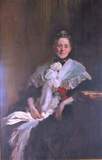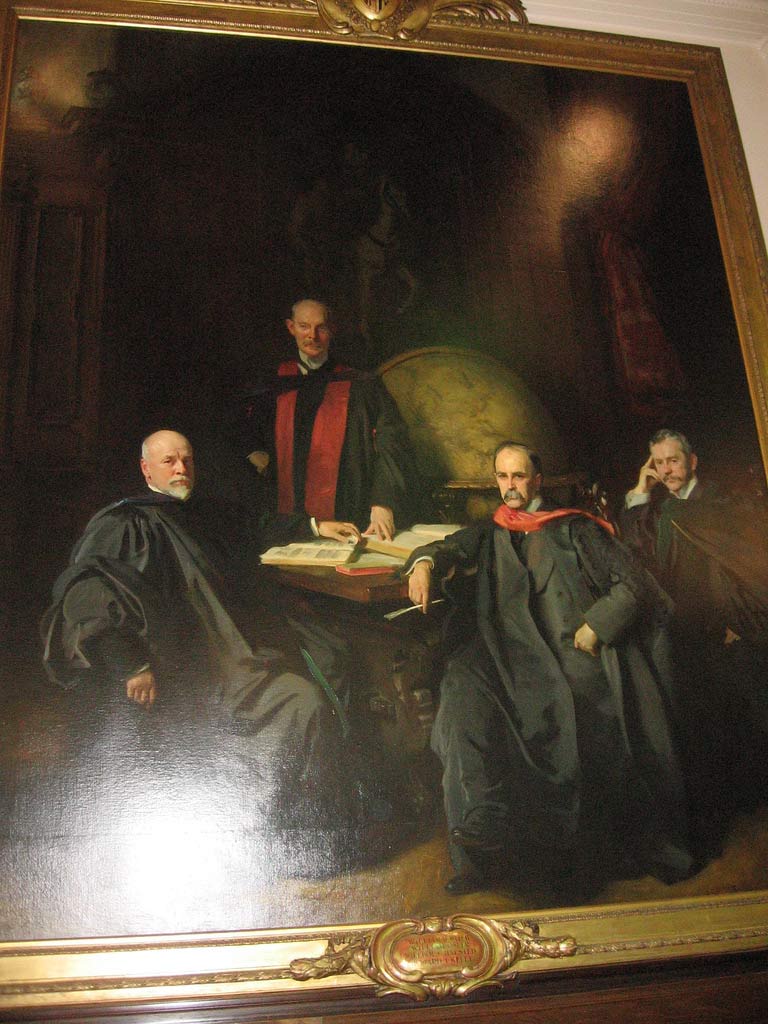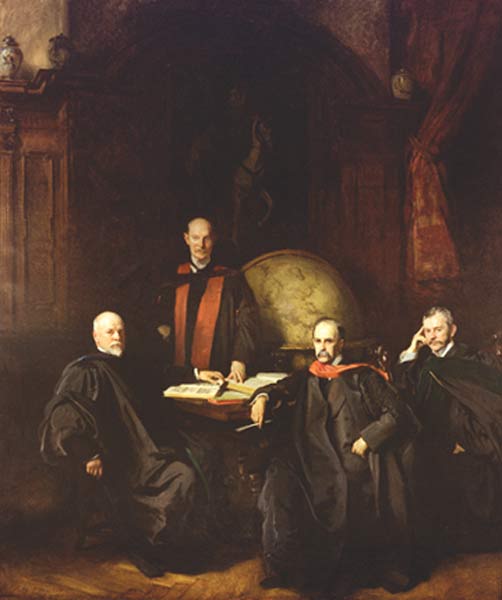|
The
Four
Doctors
1906
The
Alan
Mason Chesney
Medical Archives of The Johns Hopkins Medical Institutions, Baltimore [1]
Oil on
canvas
327.7
x 271.8
cm (129 x 109 in.)
Jpg: A.Currell
/ www.jhu.edu
The painting of the
Four
Doctors
was of the lead teaching physicians of the Johns Hopkins School of
Medicine.
They were: Dr. William H. Welch, the first Dean of the school, Dr.
William
Osler, Dr. William S. Halsted and Dr. Howard A. Kelly.
 |


Mary Elizabeth Garrett
1904

|
The painting was
commissioned by
the board of trustees in honor of Mary
Elizabeth
Garrett whom, through her generosity, had given a large endowment
for
the creation of the medical school in 1889. Garrett herself had been
painted
by Sargent in 1904; and after the success of both her portrait and her
friend's: Miss Carey Thomas, they
felt
Sargent would be the appropriate artist for this distinguished
commission.
The painting took
almost
a year to
finish and was done in his studio at Tite
Street in London.
Sargent felt the
composition was
lacking something, and upon contemplation came up with a possible
solution.
He asked the four distinguished physicians if they had any reservations
about the introduction into the background of a large, old Venetian
globe,
an object housed in the artist's other studio [at Fulham
Road]. The subjects had no misgivings and the globe was promptly
delivered
days after. Unfortunately, the globe was so massive it could not fit
through
the studio door. Undeterred, Sargent simply directed that the doorway,
and a good chunk of the wall, be chopped to permit the object's entry.
 |
El
Greco

St. Martin and the
Beggar

|
At
the next sitting Sargent swiftly drew the globe's silhouette, stood
back
and brightly remarked, "We have got our picture." Or so he thought, as
he would later add to the background a replica of El Greco's St. Martin
and the Beggar painted by Jorge Manuel Theotocopouli, El Greco's son.
It
is believed that the work, part of Sargent's own collection, was used
to
add a vertical perspective
(The
Gazette online January 29, 2001
VOL. 30, NO. 19)
Quotes regarding the
painting from contemporary
papers:
Where else in
the
present
day shall we find heads painted like these?
-The Spectator
A marvellously
fine
composition...
The dextrous way in which the artist has used the hoods, the books, and
the globe to relieve the gloom of gowns and backgrounds is beyond
praise.
-London
Times
Touches on
absolute mastery
within the limits of its aims. ...The masses of black are strong and
elastic
in structure, and each brush stroke is directly descriptive of surface
character. The background is nobly handled, and the execution
throughout
of a power and insight that belie the rather photographic arrangement
of
the subject.
-The
Athenaeum
It is a
great
portrait, because
of its sound workmanship and the stamp of originality that is upon
it.
-Royal
Cortissoz
(W.H.Downes,
John.S.Sargent His life
and work)
(Editor's
Note - the following is from an excerpt of a discussion board
online)
From: Staten
Island Talk
Date:
May 17 2005
("Art" is speaking -
Arthur O. Anderson, M.D.)
I
can recall seeing a drawing he did of Mary Elizabeth Garrett [at Johns
Hopkins] hanging
 |


Mary Elizabeth Garrett
1904

|
near the back door of the women's fund building on Wolf
Street. This was back in the early 1970's when I was a pathology
resident. This original Sargent drawing just hung there less than 4
feet from the door and with no one guarding it for quite a few years. I
guess the institution was still trusting that people would treat it
kindly and not run off with it. Eventually they moved it to a more
secure place in the building.
Later I learned that Mary Elizabeth Garrett, the wife of the guy who
created the Baltimore and Ohio Railroad, was involved in a women's
philanthropic group that created Bryn Mawr College and while they were
at it they raised enough money to allow the Johns Hopkins Hospital and
medical school to open its doors on time. It seems that Johns Hopkins'
gift had depreciated because the market wasn't doing well in the latter
half of the 19th century and the school needed an infusion of money to
open.
Mary Elizabeth's gift, merged with the gifts of other women (including
one of the Rockefeller daughters) allowed it to open on one condition.
That condition was that the medical school would have to admit women as
fully matriculating students. The trustees agreed and Hopkins was the
first medical school to admit women. Not a lot but a few each year.
One of those women was the author Gertrude Stein (a rose is a rose is a
rose!). She was a good medical student and became engaged in research
in gynecology. The ovarian disorder called Stein-Levanthal Syndrome was
partly discovered by Gertrude Stein but she quit medical school before
the end of her senior year and set up a salon in Paris, for which she
gained more fame and recognition than that of her masculinizing ovarian
syndrome.
The other great John Singer Sargent picture at Hopkins hangs (or hung
before it was sent off for curatorial care) in the Welch medical
library is the image of the famous 4 physicians Osler, Kelly, Halstead
and Welch who were involved in creating the extraordinary medical
education that Abraham Flexner considered the best medical curriculum
anywhere (. . .)
The Flexner report was very influential as defining
Johns Hopkins as the model of academic medical education. At the time
there were many so-called "proprietary" medical schools in the US. They
accepted high school graduates and gave them a "trade school" form of
medical education after which students would apprentice to practicing
physicians (sort of like the way lawyers apprenticed themselves to
practicing lawyers until ready to take the bar). The major problem is
that none of these docs had a liberal arts education let alone the
scientific education that might enable them to understand what they
were doing and it was clear that in the early 1900's medicine was prime
for a big academic boost. The Flexner Brothers Abraham (a Carnegie
Institute funded Education Expert) and Simon (a Hopkins Trained
microbiologist and head of the new Rockefeller Institute in NYC) were
very influential in getting their case across. The fact that they had
societal connections with Johns Hopkins University didn't hinder their
advocacy for their alma mater... The fact that Hopkins was destined to
live up to their claims was also set by the outstanding doctors who
intended to practice the finest medicine, teach students and fellows by
the bedside and conduct cutting edge research aimed at finding evidence
for diagnosis and treatment of disease. Opinion once held equal weight
to evidence but Osler, Welch, Halstead and Kelly were working on
changing all that and that was moving toward good medical education.
I was a University of Maryland medical student but I took clinical
clerkships at Baltimore City Hospital (now Francis Scott Key Medical
center) where the house staff and attending physicians and professors
were primarily from Johns Hopkins.
I did my internship and residency in Pathology at Johns Hopkins. I had
my first academic faculty appointment in the Department of Art as
Applied to Medicine while I served my Pathology residency. One of the
Hopkins professors at City saw some drawings I made of a 113 lb lady
who had a 50 lb ovarian tumor. When he saw them he asked me to become a
special student in the Department of Art as Applied to Medicine. I did,
and that was my introduction to medical illustration which I taught
when I wasn't doing autopsies, presenting rounds, training residents
and doing medical research.
By the way, I am actually giving a talk on medical illustration for the
Johns Hopkins alumni group. They liked my
web page and decided to find out about my Art and my Science. I put up
an album of my old art work in the photo album part of this site. Here's
the URL I put all the pictures I made that I still have in this
album. They start with a painting I did when I was 13 in 1958 and
progress through all kinds of stuff I made relatively recently.
(Staten Island Talk)
May
24 2005
Natasha, Thanks for letting me know that you added my post to your page
on the first four. I have to mention that I didn't remember exactly who
the Sargent drawing was of. It was a charcoal sketch of a woman but it
might not be Mary Elizabeth Garrett. It makes sence that it would be
but it could have been of a Rockefeller.
I remember one day while I was doing an autopsy in 1970, a spry little
lady came into the autopsy room and looked around. She was happy to see
that an example of one of the original marble necropsy tables was
mounted on the wall. The new tables were all stainless steel. After she
left, one of the senior residents mentioned that she was one of the
women, or a daughter of one, who helped endow this building. I wish I
could remember her name. At that time I didn't know of the history
about admitting female students.
One my favorite pathology professors at the time was Ella Hutzler
Oppenheimer. I believe she was a Johns Hopkins medical student in the
class of 1923. She was a sharp lady and very nice to us ambitious and
nervous post docs.
Be sure to spell Johns Hopkins correctly. The man's name was a fusion
of two prominent Quaker families. The Johns family and the Hopkins
family.
Best regards.
art
Notes:
Special thanks to
Wonsug
Jung, from
Korea, a friend
of
the JSS Gallery for sending the quoates from from contemporary
press
found in Downes' book
- See the year
in
review 1906
Forum:
From: Andrew J.
Harrison
aharriso@mail.jhmi.edu
Date: 4/3/2001
Dear Natasha,
Upon doing a search
regarding John
Singer Sargent and The Four Doctors, I happened upon your web
site.
I am writing this not to request you remove the painting but to correct
your credit line. It should read as
follows:
[corrected above]
I ask this only so
that
someone can
track it back to its source if the need arises. However, if
anyone
chooses to publish the image, they must contact the archives as Johns
Hopkins
University copyrighted the painting in 1913. Thanks and if you have any
questions, please feel free to contact me. We are currently doing
a cleaning and restoration of the work on site since it is too
big to fit out the
door. It
will appear in the updated Catalogue Raisonne when it is published
later
this year. Thanks again and I enjoyed perusing your web site.
Andy
Andrew J. Harrison
Processing Archivist
and
Fine Arts
Coordinator
The Johns Hopkins
Medical
Institutions
The Alan Mason Chesney
Medical Archives
2024 East Monument
Street
Suite 1-500
Baltimore, MD 21205
tel. 410-955-3043. fax
410-955-0810
e-mail
aharriso@jhmi.edu
|









